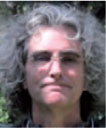Foreword. Forty years of conversations in tropospheric chemistry and public health: the legacies of Harvey E. Jeffries and Richard M. Kamens at the University of North Carolina at Chapel Hill
Jeffrey R. Arnold A and Jian Zhen Yu B CA US Army Corps of Engineers, Institute for Water Resources, and University of Washington, College of the Environment, Joint Institute for the Study of the Atmosphere and Ocean, 3737 Brooklyn Avenue NE, JM Wallace Hall, Seattle, WA 98105-6715, USA. Email: jeffrey.r.arnold@usace.army.mil
B Environmental Chemistry Editorial Board member.
C Hong Kong University of Science & Technology, Department of Chemistry and Division of Environment, Clear Water Bay, Kowloon, Hong Kong, China. Email: jian.yu@ust.hk

Jeffrey R. Arnold (Ph.D. UNC DESE, 1997) is Senior Scientist for the US Army Corps of Engineers and co-directs the Corps' climate change programs. Jeff worked closely with Harvey and Rich for more than 10 years at the UNC Ambient Air Research Facility and in the UNC numerical modelling laboratories where his ideas about how to do atmospheric science and apply science for public health benefit were deeply shaped and nurtured in conversations with Harvey and Rich. |

Jian Zhen Yu (Ph.D. UNC DESE, 1996) is a Professor in the Department of Chemistry and Division of Environment at the Hong Kong University of Science & Technology. She has been an editor of Environmental Chemistry since 2010. Jian did her Ph.D. work, under the supervision of Harvey, on product characterisation from atmospheric photooxidation of isoprene and alkylbenzenes in the UNC outdoor smog chamber. She spent 2 years as a postdoctoral fellow in Professor John Seinfeld's group at Caltech after completing her Ph.D. studies. Her current research interests in aerosol chemistry are deeply influenced by Rich's teaching of the gas–particle interaction course and conversations with Harvey and Rich throughout her UNC years and beyond. |
Environmental Chemistry 10(3) i-iv https://doi.org/10.1071/ENv10n3_FO
Published: 28 June 2013
References
[1] S. M. Aschmann, J. Arey, R. Atkinson, Reaction of OH radicals with 5-hydroxy-2-pentanone: formation yield of 4-oxopentanal and its OH radical reaction rate constant. Environ. Chem. 2013, 10, 145.| Reaction of OH radicals with 5-hydroxy-2-pentanone: formation yield of 4-oxopentanal and its OH radical reaction rate constant.Crossref | GoogleScholarGoogle Scholar |
[2] R. Beardsley, M. Jang, B. Ori, Y. Im, C. A. Delcomyn, N. Witherspoon, Role of sea salt aerosols in the formation of aromatic secondary organic aerosol: yields and hygroscopic properties. Environ. Chem. 2013, 10, 167.
| Role of sea salt aerosols in the formation of aromatic secondary organic aerosol: yields and hygroscopic properties.Crossref | GoogleScholarGoogle Scholar |
[3] Y. Zhou, E. P. Rosen, H. Zhang, W. Rattanavaraha, W. X. Wang, R. M. Kamens, SO2 oxidation and nucleation studies at near-atmospheric conditions in outdoor smog chamber. Environ. Chem. 2013, 10, 210.
| SO2 oxidation and nucleation studies at near-atmospheric conditions in outdoor smog chamber.Crossref | GoogleScholarGoogle Scholar |
[4] R. G. Derwent, T. P. Murrells, Are photochemical oxidant control strategies robust to the choice of chemical mechanism? Environ. Chem. 2013, 10, 234.
| Are photochemical oxidant control strategies robust to the choice of chemical mechanism?Crossref | GoogleScholarGoogle Scholar |
[5] H. M. Parikh, H. E. Jeffries, K. G. Sexton, D. J. Luecken, R. M. Kamens, W. Vizuete, evaluation of aromatic oxidation reactions in seven chemical mechanisms with an outdoor chamber. Environ. Chem. 2013, 10, 245.
| evaluation of aromatic oxidation reactions in seven chemical mechanisms with an outdoor chamber.Crossref | GoogleScholarGoogle Scholar |
[6] J. R. Kirkland, Y. B. Lim, Y. Tan, K. E. Altieri, B. J. Turpin, Glyoxal secondary organic aerosol chemistry: effects of dilute nitrate and ammonium and support for organic radical–radical oligomer formation. Environ. Chem. 2013, 10, 158.
| Glyoxal secondary organic aerosol chemistry: effects of dilute nitrate and ammonium and support for organic radical–radical oligomer formation.Crossref | GoogleScholarGoogle Scholar |
[7] M. Jaoui, T. E. Kleindienst, K. S. Docherty, M. Lewandowski, J. H. Offenberg, Secondary organic aerosol formation from the oxidation of a series of sesquiterpenes: α-cedrene, β-caryophyllene, α-humulene and α-farnesene with O3, OH and NO3 radicals. Environ. Chem. 2013, 10, 178.
| Secondary organic aerosol formation from the oxidation of a series of sesquiterpenes: α-cedrene, β-caryophyllene, α-humulene and α-farnesene with O3, OH and NO3 radicals.Crossref | GoogleScholarGoogle Scholar |
[8] H. F. Zhang, H. M. Parikh, J. Bapat, Y.-H. Lin, J. D. Surratt, R. M. Kamens, Modelling of secondary organic aerosol formation from isoprene photooxidation chamber studies using different approaches. Environ. Chem. 2013, 10, 194.
| Modelling of secondary organic aerosol formation from isoprene photooxidation chamber studies using different approaches.Crossref | GoogleScholarGoogle Scholar |
[9] N. M. Donahue, W. Chuang, S. A. Epstein, J. H. Kroll, D. R. Worsnop, A. L. Robinson, P. J. Adams, S. N. Pandis, Why do organic aerosols exist? Understanding aerosol lifetimes using the two-dimensional volatility basis set. Environ. Chem. 2013, 10, 151.
| Why do organic aerosols exist? Understanding aerosol lifetimes using the two-dimensional volatility basis set.Crossref | GoogleScholarGoogle Scholar |
[10] E. Couzo, H. E. Jeffries, W. Vizuete, Houston’s rapid ozone increases: preconditions and geographic origins. Environ. Chem. 2013, 10, 260.
| Houston’s rapid ozone increases: preconditions and geographic origins.Crossref | GoogleScholarGoogle Scholar |
[11] C. B. Faxon, D. T. Allen, Chlorine chemistry in urban atmospheres: a review. Environ. Chem. 2013, 10, 221.
| Chlorine chemistry in urban atmospheres: a review.Crossref | GoogleScholarGoogle Scholar |


